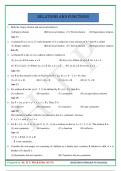RELATIONS AND FUNCTIONS
1. Both the empty relation and universal relation is
(A)Empty relation (B)Universal relation (C) Trivial relation (D) Equivalence relation
Ans (C)
2. A relation R in a set A, if “each elements of A is related to every element of A ” then R is called
(A) Empty relation (B)Universal relation (C) Trivial relation (D) Equivalence relation
Ans (B)
3. A relation R in the set A is called a reflexive relation if,
(A) a,a R, for some a A (B) If a,b R then b,a R for a,b A
(C) If a,b , b,c R then a,c R for a,b,c A (D) a,a R, for every a A
Ans: (D)
4. Let R be the relation in the set N given by R = {(a, b): a = b 2, b > 6}, then
(A) (2, 4) R (B) (3, 8) R (C) (6, 8) R (D) (8, 7) R
Ans (C)
5. If a relation R on the set {1, 2, 3} be defined by R = {(1, 2)}, then R is
(A) reflexive (B) transitive (C) symmetric (D) an equivalence relation
Ans (B)
6. Let P = {(x, y) |x + y = 1, x, y R}. Then, P is
2 2
(A) reflexive (B) symmetric (C) transitive (D) anti-symmetric
Ans (B)
The relation is neither reflexive nor transitive but it is symmetric, because
x2 + y2 = 1 and y2 + x2 = 1
7. Let R = {(1, 3), (4, 2), (2, 4), (2, 3), (3, 1)} be a relation on the set A = {1, 2, 3, 4}. The relation R is
(A) not symmetric (B) transitive (C) a function (D) reflexive
Ans (A)
(2, 3) R but (3, 2) R
R is not symmetric.
8. Consider the non-empty set consisting of children in a family and a relation R defined as aRb, if a is
brother of b. then R is
(A) Symmetric but not transitive (B) Transitive but not symmetric
Prepared by: Dr. H. T. PRAKASHA (H T P) BASE EDUCATION (RV PU COLLEGE)
, (C) Neither symmetric nor Transitive (D) both symmetric and transitive
Ans (B)
9. Let L denote the set of all straight lines in a plane. Let relation R be defined by lRm if and only if l is
perpendicular to m , for all l , m L . Then R is
(A) reflexive (B) transitive (C) symmetric (D) an equivalence relation
Ans (C)
10. Let A = {1, 2, 3}. Then number of relations containing (1, 2) and (1, 3) which are reflexive and
symmetric but not transitive is
(A) 1 (B) 2 (C) 3 (D) 4
Ans (A)
We get only one relation R = (1, 1), (2, 2), (3, 3), (1, 2), (1, 3), (2, 1), (3, 1)
11. If R1 and R2 are two equivalence relations on a non-empty set A, then R1 R2 is not
(A) reflexive (B) symmetric (C) transitive (D) an equivalence relation
Ans (C)
Let A = {1, 2, 3}
Consider the example R1 = {(1, 1) (2, 2) (3, 3) (1, 2) (2, 1)}
R2 = {(1, 1) (2, 2) (3, 3) (2, 3) (3, 2)}
Here R1 and R2 are equivalence.
But R1 R2 is not transitive. For R1 R2 = {(1, 1) (2, 2) (3, 3) (1, 2) (2, 1) (2, 3) (3, 2)}
(1, 2) R1 R2, (2, 3) R1 R2 but (1, 3) R1 R2
12. Let A = {1, 2, 3}. Then number of equivalence relations containing (1, 2) is
(A) 1 (B) 2 (C) 3 (D) 4
Ans (B)
R1 = (1, 1), (2, 2), (3, 3), (1, 2), (2, 1)
R2 = (1, 1), (2, 2), (3, 3), (1, 2), (2, 1), (1, 3), (3, 1), (2, 3), (3, 2) are the equivalence relations.
13. The number of equivalence relations defined in the set S = {a, b, c} is
(A) 5 (B) 3! (C) 22 (D) 33
Ans (A)
14. Which of the following relation in the set 1, 2,3 is symmetric and transitive but not reflexive?
A) 1, 2 , 2, 2 ,1,1 (B) 1,2 , 2,1 (C) 2,3 (D) 1,2 , 2,1 , 2,2 ,1,1
Ans (D)
15. Let R be a relation on the set N of Natural numbers defined by nRm if “n divides m” then R is
Prepared by: Dr. H. T. PRAKASHA (H T P) BASE EDUCATION (RV PU COLLEGE)




